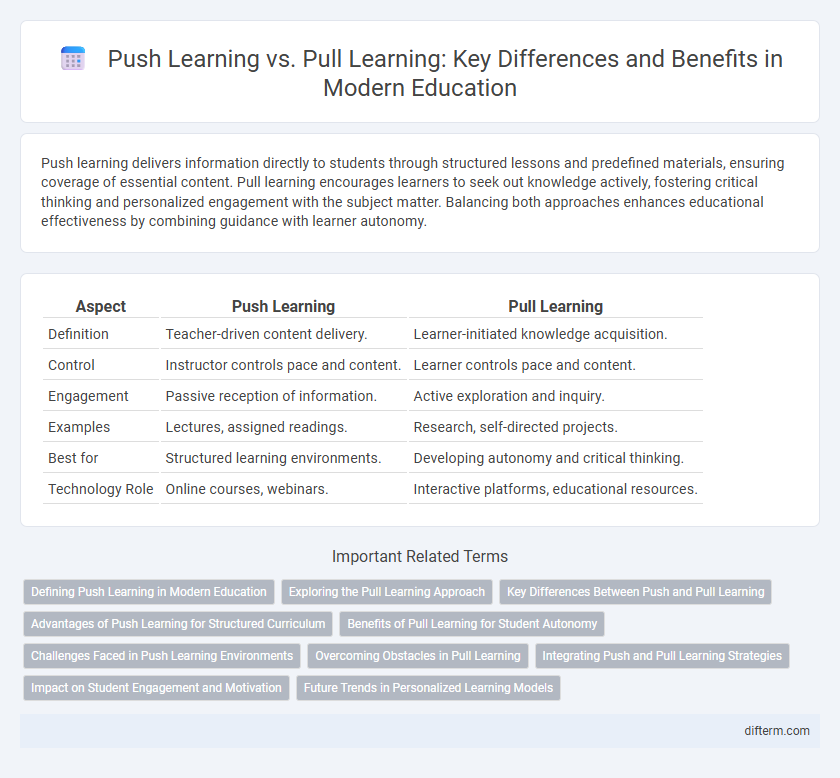Push learning delivers information directly to students through structured lessons and predefined materials, ensuring coverage of essential content. Pull learning encourages learners to seek out knowledge actively, fostering critical thinking and personalized engagement with the subject matter. Balancing both approaches enhances educational effectiveness by combining guidance with learner autonomy.
Table of Comparison
| Aspect | Push Learning | Pull Learning |
|---|---|---|
| Definition | Teacher-driven content delivery. | Learner-initiated knowledge acquisition. |
| Control | Instructor controls pace and content. | Learner controls pace and content. |
| Engagement | Passive reception of information. | Active exploration and inquiry. |
| Examples | Lectures, assigned readings. | Research, self-directed projects. |
| Best for | Structured learning environments. | Developing autonomy and critical thinking. |
| Technology Role | Online courses, webinars. | Interactive platforms, educational resources. |
Defining Push Learning in Modern Education
Push learning in modern education refers to a structured approach where instructional content is delivered directly by educators or platforms to students, often through scheduled lessons, lectures, or assigned materials. This method emphasizes teacher-led dissemination of knowledge, ensuring all learners receive the same information in a timely manner. Push learning remains essential for foundational skill development and standardized curriculum delivery in contemporary classrooms.
Exploring the Pull Learning Approach
Pull learning emphasizes student-driven inquiry, allowing learners to seek out resources and knowledge based on their interests and pace. This approach fosters critical thinking and autonomy by encouraging active exploration rather than passive reception of information. Educational technologies, such as online platforms and interactive modules, enhance pull learning by providing immediate access to vast, diversified content tailored to individual learning paths.
Key Differences Between Push and Pull Learning
Push learning involves the instructor-driven delivery of content where information is pushed to learners in a structured format, often through lectures or assigned materials. Pull learning is learner-centered, relying on the individual's initiative to seek out, explore, and absorb knowledge at their own pace using resources like online databases, forums, and research tools. The key differences lie in control and engagement: push learning emphasizes systematic content dissemination, while pull learning fosters autonomy and self-directed exploration.
Advantages of Push Learning for Structured Curriculum
Push learning ensures a consistent delivery of curriculum content, facilitating a well-organized educational framework that supports systematic knowledge acquisition. This approach allows educators to maintain control over pacing and sequencing, ensuring all students receive core information essential for academic success. Structured curriculum through push learning enhances learner readiness for assessments by reinforcing foundational concepts in a predictable manner.
Benefits of Pull Learning for Student Autonomy
Pull learning empowers students by allowing them to actively seek and access resources tailored to their individual needs, fostering deeper engagement and personalized understanding. This approach enhances critical thinking and self-regulation, as learners take responsibility for their educational journey and pace. Increased autonomy in pull learning leads to improved motivation and adaptability, essential skills for lifelong learning in dynamic environments.
Challenges Faced in Push Learning Environments
Push learning environments often struggle with low student engagement as information is delivered passively, limiting interaction and critical thinking. This approach can result in knowledge retention issues since learners receive content without adequate opportunities for exploration or application. Inflexible pacing and standardized instruction further hinder personalization, making it difficult to address diverse learning styles and needs effectively.
Overcoming Obstacles in Pull Learning
Overcoming obstacles in pull learning involves enhancing student motivation and providing seamless access to resources, enabling learners to actively seek knowledge at their own pace. Integrating adaptive technologies and personalized content addresses diverse learning styles, mitigating challenges related to self-regulation and information overload. Effective support systems, such as mentorship and peer collaboration platforms, further empower learners to navigate complexities inherent in pull learning environments.
Integrating Push and Pull Learning Strategies
Integrating push and pull learning strategies enhances educational effectiveness by combining structured content delivery with learner-driven exploration, fostering deeper understanding and engagement. Push learning provides essential foundational knowledge through targeted information dissemination, while pull learning encourages critical thinking and personalized knowledge acquisition by allowing learners to seek resources based on their interests. This balanced approach supports diverse learning styles and improves knowledge retention by promoting active participation alongside guided instruction.
Impact on Student Engagement and Motivation
Push learning, characterized by teacher-directed content delivery, often limits student autonomy, resulting in lower engagement and motivation compared to pull learning approaches. Pull learning empowers students to seek out information based on their interests, fostering deeper intrinsic motivation and active participation. Studies show pull learning strategies enhance critical thinking and retention by aligning educational content with individual learning preferences.
Future Trends in Personalized Learning Models
Push learning delivers content through structured curricula and educator-led instruction, while pull learning empowers students to seek resources based on individual interests and pace. Future trends in personalized learning models emphasize adaptive learning technologies, leveraging AI to tailor content dynamically to each learner's needs. These emerging approaches enhance engagement and improve outcomes by addressing diverse learning styles and fostering learner autonomy.
Push learning vs Pull learning Infographic

 difterm.com
difterm.com